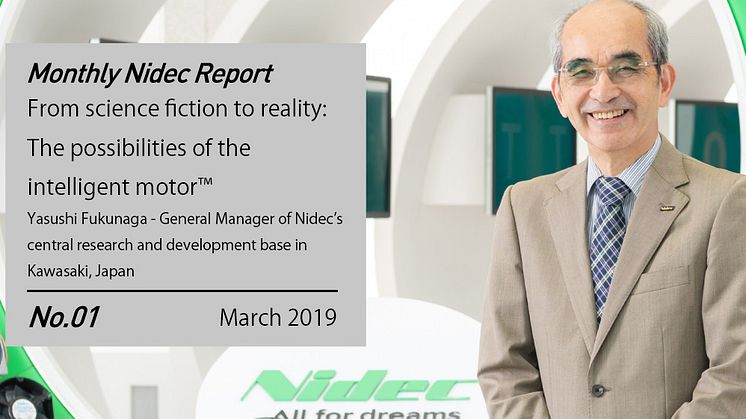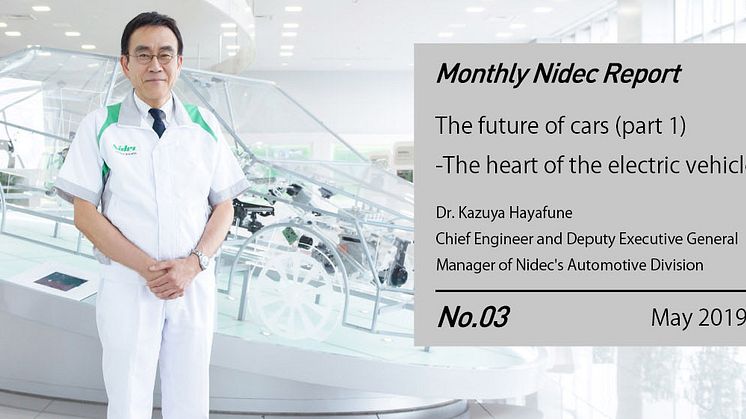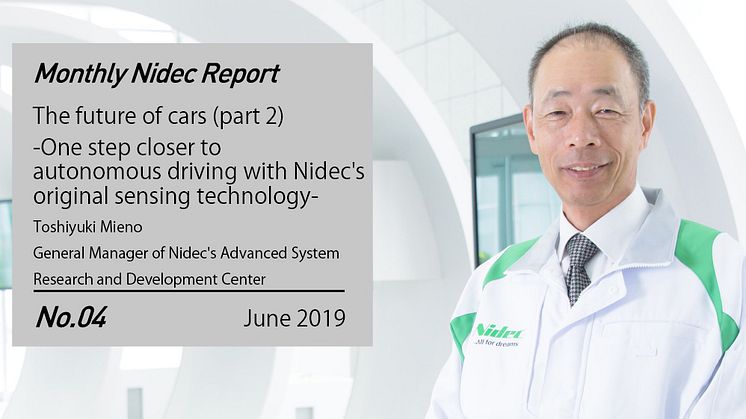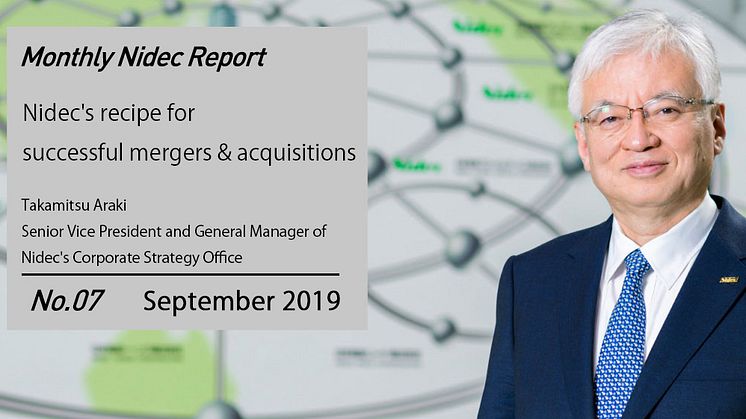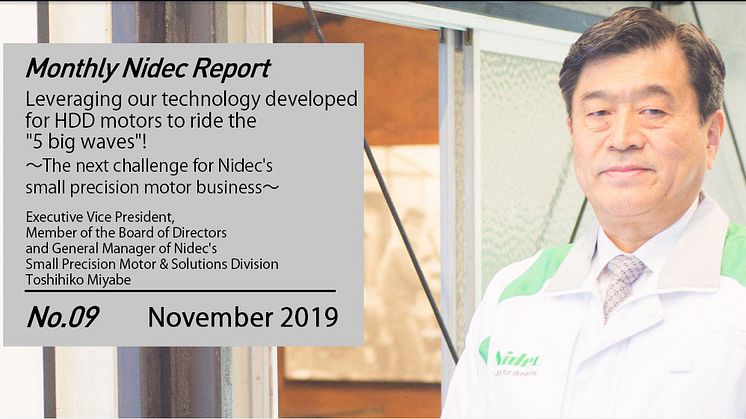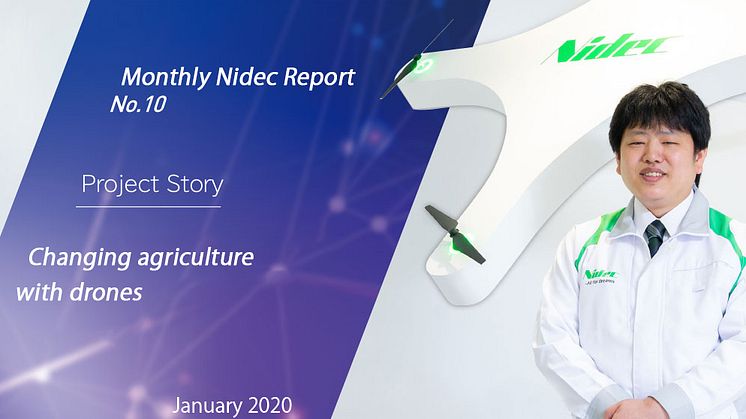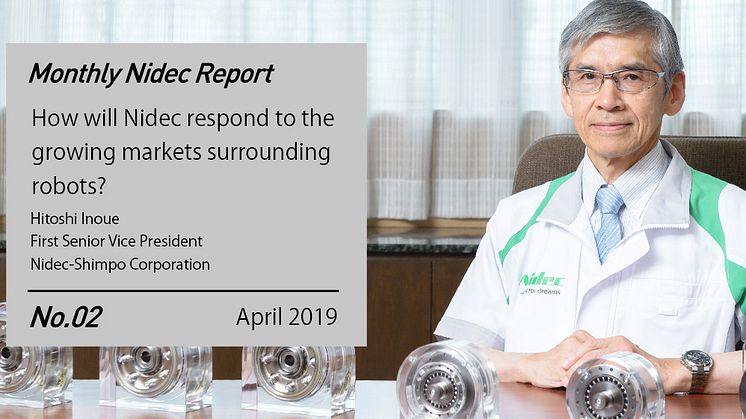
Blog post -
Monthly Nidec Report - How will Nidec respond to the growing markets surrounding robots?
Robots, no longer confined to factories, are becoming more and more common both in the service industry and in various domestic applications. As a result, the demand for motors, and the gears that accompany them, is growing rapidly. The Nidec group company Nidec-Shimpo has taken this opportunity to tap into new markets like high-performance speed reducer gears for robots, and automated guided vehicles.
Speed reducers—the faithful companion of motors
- Let's start with a short introduction of Nidec-Shimpo.
All right. Nidec-Shimpo was founded in 1952, in Kyoto, as Japan's first manufacturer of continuously variable speed drives for industrial applications. Since our foundation, we have honed our technology to the point where we have become one of the forerunners in Japan when it comes to speed reducer and gearbox technology. Currently, we supply 55% of the domestic market for speed reducers for servo motors—the type of motor that makes up the bulk of the industrial segment. We have also captured 35% of the market share in China, a country with a truly large market for motors.
A speed reducer is a device that, when attached to a motor, decreases the rotational speed of the system while increasing the torque. Apart from a limited number of applications—electric fans, vacuum cleaners, drones and other air-related applications that favor high rotational speeds—most machines equipped with motors also use speed reducers. For example, an industrial conveyor belt driven by a motor with an RPM of 1800 would move material too fast for assembly line workers to keep up, and the conveyor belt would come to a standstill if you placed a heavy object on it due to insufficient torque. But, if you attach a speed reducer with a reduction ratio of 1/20 to the motor, the RPM would be reduced by a factor of 20, resulting in a reasonable speed for a conveyor belt, while the torque would increase 20-fold, making it possible to move heavy objects without problems.
In this way, most applications that use motors require speed reducers as well to achieve the desired rotational speed and torque. Thus, it can be said that the relationship between motors and speed reducers is quite intimate.
Electric motors are characterized by their high efficiency. While the energy efficiency ratios of steam or gasoline engines, some of the historical alternatives to electric motors, are typically in the region of 10% and 30-35% respectively, most motors are between 70-80%; particularly highly-efficient designs even exceed 90%. It is no wonder that people look to electric motors as the future source of mechanical energy, especially when it comes to cutting-edge technologies like robotics. As a result, we expect that the market for motors and speed reducers will keep on expanding. Nidec meets the demand for the motors, and Nidec-Shimpo designs the speed reducers that go along with them—that's our approach.
Breaking into new difficult markets
- What prompted you to start developing specialized speed reducers for robotic applications?
At Nidec-Shimpo, our policy is to look at megatrends while developing new technologies and products. Megatrends are powerful forces that aren't easily swayed or stopped by current ideas or trends. One such megatrend, particularly noticeable in Japan and China, is the decreasing birthrate combined with an aging population and the resulting labor shortage that is becoming more and more serious. As a result, robots are expected to see more and more use in factories, nursing care and various other areas and the demand for robots will grow rapidly in many different fields and industries—our decision to start focusing on full-scale R&D of robotic speed reducers in 2011 was based on this prediction. However, it was by no means an easy task. At the time, industrial robots were starting to see widespread use in factories around the world, but the market for robotic speed reducers was effectively controlled by three leading manufacturers and the barrier to entry was very high. There were other companies—gear manufacturers, machine manufacturers and automakers among others—who tried their hand at developing speed reducers for robots, but the research was technically difficult so most gave up. That’s how difficult it was.

- How did you manage to overcome these hurdles and succeed at developing your line of robotic speed reducers then?
Robotic speed reducers need to have a high reduction ratio while also being thin, strong and precise. The only way that you can satisfy all of these conditions is with extremely advanced machining technology, and this is the reason why so many companies gave up and cancelled their robotic speed reducer R&D programs. In our case, however, there was a lot of overlap with the machining technologies that we had accumulated from our early years when we developed continuously variable speed drives. By leveraging this craftsmanship and staying true to Nidec's corporate philosophy of never giving up, we finally managed, through a lot of effort, to develop our first speed reducer for robots: FLEXWAVE™. The principle technology behind the FLEXWAVE™ was conceived 40 years ago or so in the US, but due to the difficulties involved in machining the gears, very few companies have succeeded in commercializing the technology. By developing specialized proprietary machining technology, tools and inspection equipment, we were able to do just that. After that, we finished developing our second robotic speed reducer: CORONEX. This product is similar to the FLEXWAVE, but uses a different configuration to achieve a higher torque output. CORONEX is suitable for applications where a high torque is required, such as the base, shoulder and elbow joints of six axis robots, while FLEXWAVE shines in applications like wrist joints where light weight and precision are favored.
As I mentioned, the market for robotic speed reducers has been cornered by a few leading companies and we have just started to break into the field, but our CORONEX has the advantage of being more silent and energy-efficient than competing products. It also has a hollow structure that makes it possible to pass wiring through the speed reducer. Moving forward, we are focusing our R&D efforts on increasing the competitiveness of the cost.
Nidec-Shimpo's speed reducers for high precision motion control: FLEXWAVE and CORONEX
Strength through synergy—motors and speed reducers under one umbrella
- How did you manage to overcome these hurdles and succeed at developing your line of robotic speed reducers then?
We are still behind the more established companies in terms of production capacity—for FLEXWAVE, we have about one third of the production capacity of our competitors and currently we are receiving new orders at a faster pace than we can manufacture. This really shows how sharp the global rise in demand is. Just a year ago, in April 2018, we started operations at a dedicated factory in Nagano prefecture, Japan. Preparations are also underway to start manufacturing speed reducers at our new factory in the Philippines. Together with our factory in Nagaokakyo city, Japan we plan to increase production to 200,000 units per month.
In 2016, we also launched our super flat actuator—a robotic speed reducer with a Nidec-designed motor integrated into the hollow center space. Recognized as thinnest in the industry this product received the grand prize in the Top Manufacturing Parts Awards presented during the Japan Manufacturing Conference 2017. Due to its thinness, it is especially well suited for use in powered exoskeletons or the wheels of electric wheelchairs. Our main competitors are dedicated speed reducer manufacturers, so one of our biggest strengths and assets is that, in addition to our own speed reducers, we also have access to technologies related to motors, electronic circuits and software through the other companies in the Nidec group. Moving forward, we will keep working closely together with the Nidec Research and Development Center, the Nidec Center for Industrial Science and also with universities like the University of Tokyo. In this way, we can develop new speed reducers and motors that are optimized for use with each other. I think this is where our true competitive advantage lies.

 One of the areas we want to concentrate on in the future is traction drives—speed reducers that use cylinders instead of toothed gears and rely on friction to transmit power. Normally, metallic objects are worn down from abrasion when pressed against each other in this way, but by using special grease and a 1 micrometer film of a special oil between the moving parts, you can avoid direct contact. It's a very advanced and precise technology, but at its core it is similar to the continuously variable speed drives that were the starting point of Nidec-Shimpo. Very few companies around the world are capable of manufacturing these speed reducers so we are quite confident in our competitive advantage. The greatest benefit of traction drives is that they are very silent due to not using toothed gears. This makes them especially suitable for use in social robots and carrier robots designed for service and healthcare applications and other situations in which they interact with humans. These types of robots are expected to become more and more common, and a lot of emphasis is placed on silent operation. Superior performance in terms of rotational speed and torque do not mean anything if the speed reducer produces too much noise. Thus, we expect that silent operation will become the new focus in the competition as an essential feature.  A traction drive used in an automated guided vehicle |

The evolution of the S-CART™ AGV—from component to final product
- Tell us about the S-CART™ AGV that you launched in 2016.
This product too was born out of our policy to research and develop based on megatrends. With the growth of online shopping combined with a labor shortage, finding workers to staff warehouses and distribution centers is getting increasingly difficult. Consequently, we concluded that the need for robots that can carry around goods will increase. At the time, Nidec-Shimpo had already been offering a drive unit solution for AGVs, Automated Guided Vehicles, consisting of motors, speed reducers and wheels, but we figured that if there is a market for these robots, we might as well develop the entire robot and not only the wheel units. This is what sparked the development of the S-CART.
The main feature of the S-CART is its ability to operate without magnetic tape. Conventional AGVs follow tracks made out of magnetic tape entrenched in the floor, but Nidec-Shimpo's S-CART instead uses laser positioning to create a map of its surroundings and then compare its position to the map. This allows for more flexibility when it comes to changing the layout of warehouses and factories and makes it easier than ever before to incorporate AGVs into your manufacturing or distribution process.

- The competition in the logistics equipment industry is said to be intense. How is the S-CART holding up?
The S-CART is the most compact AGV in the 100 kg payload class out in the market so we think the potential demand is quite high. We started out by developing a 100 kg payload model for warehouse use, but after being approached by construction companies expressing interest in using the S-CART at construction sites to carry material we expanded the lineup with a 500 kg and a 1000 kg model. During the past two years, we have also designed a variety of models with added functions like traction capability, lift function, conveyor belts and automatic charging.
S-CARTs at work in a factory
The latest models are capable of tracking and following people around or returning to a designated location while dodging obstacles along the way, making them suitable for use in hotel settings for example. Since our AGVs use the traction drive reducers I talked about earlier, their wheels are incredibly silent. Due to this quality, they can be adapted for use in a number of different situations; for example, they could be used in hospitals to carry food to patients, or in apartments to gather and dispose of garbage. By designing smaller versions, we could potentially open up a range of other new applications as well.
Demonstration of the S-CART and how it can be used in a hotel setting
Looking forward, we are considering expanding into the Chinese market as well. Japanese companies can be conservative when it comes to trying new products and solutions, whereas, in our experience, Chinese companies are generally more open to trying out new things. As more and more people start using our products, I am confident that we will discover new interesting applications.

- Lastly, what are your plans for the future?
Our goal when it comes to speed reducers is to expand our offering and become a comprehensive speed reducer manufacturer. We still have some way to go before we can truly call ourselves a manufacturer with a comprehensive lineup. One of the things we would like to do is expand our lineup by offering more right angle shaft type, hypoid type and worm type speed reducers. A greengrocer's shop—for example—that only sells tomatoes, no matter how delicious, will only get so far; if you want to get more business, you need to stock cucumbers, carrots, eggplants, pumpkins, and so on. Once you have a comprehensive lineup of vegetables, you will get more customers and more people will buy your tomatoes as well. In the same way, by expanding our lineup, we can increase awareness of our technological capabilities and generate more business. Our aim is to become No. 1 by offering a comprehensive lineup, sort of like a virtual department store for speed reducers.
Our goal for the S-CART is to continue pushing forward with our idea of making it easier to transport material, while aiming for the No. 1 position armed with our “guideless operation” feature that doesn’t require magnetic tape. By building on, and improving, existing autonomous driving technology, we will develop more flexible AGVs capable of more complex movements. Through doing this, we hope that we can expand on the current areas of application of the S-CART—manufacturing, construction and logistics—and adapt the S-CART for use in hotels, apartments and offices for example. Development is underway of new models with shapes and control methods optimized for these markets to create a more user friendly experience. Currently, we are mostly focusing on the domestic Japanese market, but moving forward we hope that we can get a foothold in the Chinese market, break into the American and European markets as well and eventually reach our goal of becoming No. 1 in the world.
